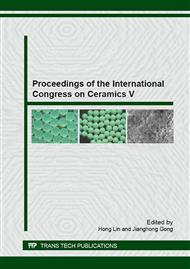p.87
p.92
p.97
p.103
p.108
p.114
p.118
p.122
p.126
Preparation and Characterization of Al2O3-Based Composite Membranes by Sol-Gel Method
Abstract:
Porous Al2O3-SiO2-ZrO2 ceramic composite membranes were fabricated by the sol-gel method. The effects of constitution of the composite sol, dip-coating parameters and calcination parameters on the morphology, phase composition, pore size distribution and BET surface area of the membranes were investigated extensively. The thermogravimetric analysis (TGA)/differential scanning calorimeters (TG/DSC), scanning Electron Microscopy (SEM), XRD analysis and N2 adsorption-desorption analysis was employed for the membranes characterization. TG/DSC curve shows that the suitable calcination temperature of Al2O3-SiO2-ZrO2 membranes is 1000°C. The SEM morphology displays a smooth and free-crack layer of Al2O3-SiO2-ZrO2 composite membranes on the surface of the support after calcination at 1000°C. Furthermore, the membranes were also successfully coated with a good adhesion to the support. The optimal composite membranes were obtained when the moral ratio of Al2O3-SiO2-ZrO2 was 10:2.3:1, the dip-coating parameters were four times dip-coating with every time of 60s respectively.
Info:
Periodical:
Pages:
108-113
Citation:
Online since:
July 2015
Authors:
Keywords:
Price:
Сopyright:
© 2015 Trans Tech Publications Ltd. All Rights Reserved
Share:
Citation:


